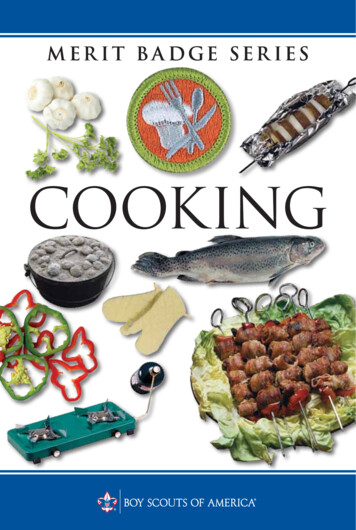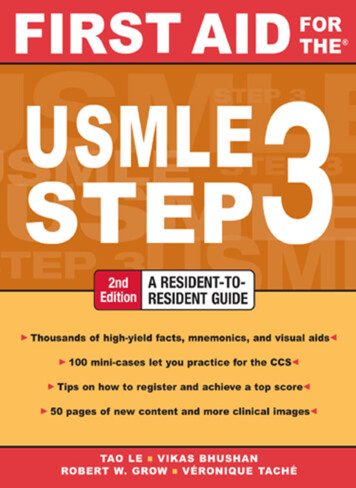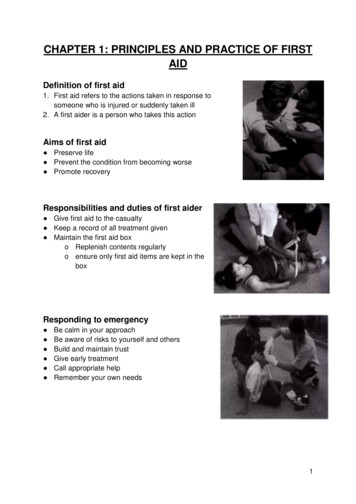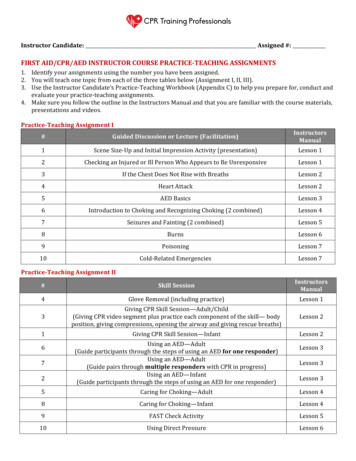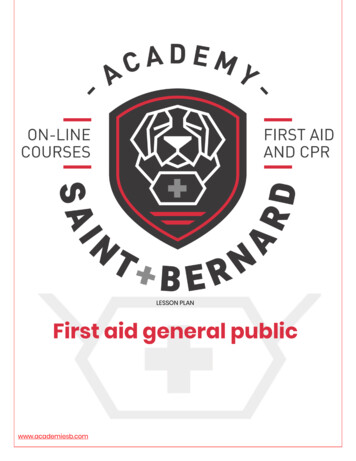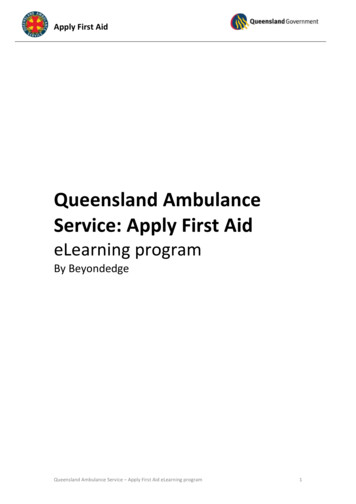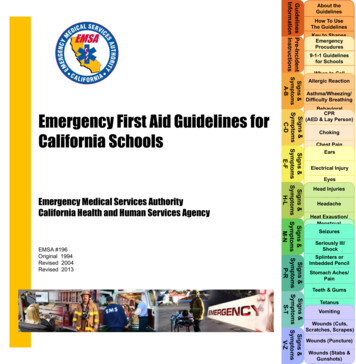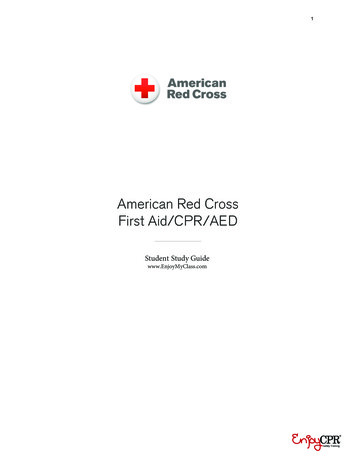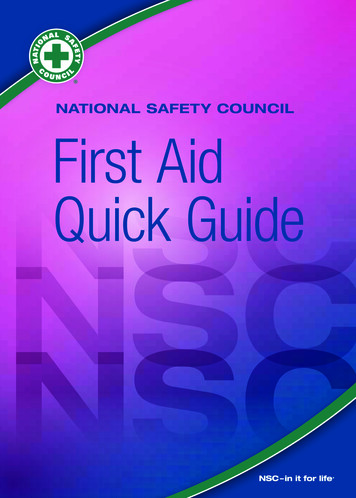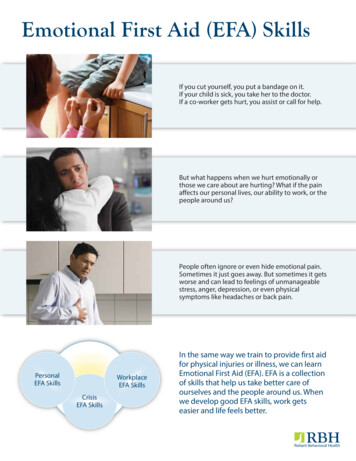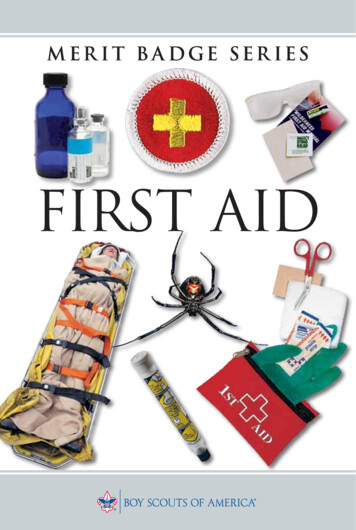
Transcription
FIRST AID
How to Use This PamphletThe secret to successfully earning a merit badge is for you to use boththe pamphlet and the suggestions of your counselor.Your counselor can be as important to you as a coach is to an athlete.Use all of the resources your counselor can make available to you.This may be the best chance you will have to learn about this particularsubject. Make it count.If you or your counselor feels that any information in this pamphlet isincorrect, please let us know. Please state your source of information.Merit badge pamphlets are reprinted annually and requirementsupdated regularly. Your suggestions for improvement are welcome.Send comments along with a brief statement about yourself to YouthDevelopment, S209 Boy Scouts of America 1325 West Walnut HillLane P.O. Box 152079 Irving, TX 75015-2079.Who Pays for This Pamphlet?This merit badge pamphlet is one in a series of more than 100 coveringall kinds of hobby and career subjects. It is made available for youto buy as a service of the national and local councils, Boy Scouts ofAmerica. The costs of the development, writing, and editing of themerit badge pamphlets are paid for by the Boy Scouts of America inorder to bring you the best book at a reasonable price.
BOY SCOUTS OF AMERICAMERIT BADGE SERIESfirst aidThe Boy Scouts of America is indebted to the AmericanRed Cross for its subject matter expertise, review,and other assistance with this edition of the First Aidmerit badge pamphlet.
Requirements1. Satisfy your counselor that you have current knowledgeof all first-aid requirements for Tenderfoot, Second Class,and First Class ranks.2. Do the following:a. Explain how you would obtain emergency medicalassistance from your home, on a wilderness campingtrip, and during an activity on open water.b. Explain the term triage.c.Explain the standard precautions as applied tobloodborne pathogens.d. Prepare a first-aid kit for your home. Display anddiscuss its contents with your counselor.3. Do the following:a. Explain what action you should take for someonewho shows signals of shock, for someone whoshows signals of a heart attack, and for someonewho shows signals of stroke.b. Identify the conditions that must exist beforeperforming CPR on a person. Then demonstrateproper technique in performing CPR using a trainingdevice approved by your counselor.c.Explain the use of an automated externaldefibrillator (AED).d. Show the steps that need to be taken for someonesuffering from a severe cut on the leg and on thewrist. Tell the dangers in the use of a tourniquet andthe conditions under which its use is justified.e.35897ISBN 978-0-8395-3301-6 2007 Boy Scouts of America2010 PrintingExplain when a bee sting could be life threateningand what action should be taken for preventionand for first aid.BANG/Brainerd, MN3-2010/059719
f.Explain the symptoms of heatstroke and what actionshould be taken for first aid and for prevention.4. Do the following:a. Describe the signals of a broken bone. Show first-aidprocedures for handling fractures (broken bones),including open (compound) fractures of theforearm, wrist, upper leg, and lower leg usingimprovised materials.b. Describe the symptoms and possible complicationsand demonstrate proper procedures for treatingsuspected injuries to the head, neck, and back.Explain what measures should be taken to reducethe possibility of further complicating these injuries.5. Describe the symptoms, proper first-aid procedures, andpossible prevention measures for the following conditions:a. Hypothermiab. Convulsions/seizuresc.Frostbited. Dehydratione.Bruises, strains, sprainsf.Burnsg. Abdominal painh. Broken, chipped, or loosened toothi.Knocked out toothj.Muscle cramps6. Do TWO of the following:a. If a sick or an injured person must be moved, tellhow you would determine the best method.Demonstrate this method.b. With helpers under your supervision, improvise astretcher and move a presumably unconscious person.c.With your counselor’s approval, arrange a visit withyour patrol or troop to an emergency medical facilityor through an American Red Cross chapter for ademonstration of how an AED is used.7. Teach another Scout a first-aid skill selected byyour counselor.first aid3
ContentsIntroduction . . . . . . . . . . . . . . . . . . . . . . . . . . . . . . . . . . . . . 7Reducing Risk. . . . . . . . . . . . . . . . . . . . . . . . . . . . . . . . . . 9How to Handle an Emergency. . . . . . . . . . . . . . . . . . . . . . . . 111. Check the Scene. . . . . . . . . . . . . . . . . . . . . . . . . . . . . . 112. Call for Help . . . . . . . . . . . . . . . . . . . . . . . . . . . . . . . . . 123. Approach Safely. . . . . . . . . . . . . . . . . . . . . . . . . . . . . . . 134. Provide Urgent Treatment. . . . . . . . . . . . . . . . . . . . . . . . 155. Protect From Further Injury. . . . . . . . . . . . . . . . . . . . . . 166. Treat Every Accident Victim for Shock . . . . . . . . . . . . . . 177. Make a Thorough Examination. . . . . . . . . . . . . . . . . . . . 188. Plan a Course of Action. . . . . . . . . . . . . . . . . . . . . . . . . 19First-Aid Supplies and Skills . . . . . . . . . . . . . . . . . . . . . . . . . 21Personal First-Aid Kit. . . . . . . . . . . . . . . . . . . . . . . . . . . . . 21Home or Patrol/Troop First-Aid Kit. . . . . . . . . . . . . . . . . . . 22Moving an Ill or Injured Person . . . . . . . . . . . . . . . . . . . . . 23Minor Wounds and Injuries. . . . . . . . . . . . . . . . . . . . . . . . . . 31Bruises . . . . . . . . . . . . . . . . . . . . . . . . . . . . . . . . . . . . . . . 31Puncture Wounds . . . . . . . . . . . . . . . . . . . . . . . . . . . . . . . 32Cuts and Scrapes (Abrasions). . . . . . . . . . . . . . . . . . . . . . . 34Blisters on the Hand and Foot . . . . . . . . . . . . . . . . . . . . . . 36Muscle, Joint, and Bone Injuries . . . . . . . . . . . . . . . . . . . . . . 38Muscle Cramps . . . . . . . . . . . . . . . . . . . . . . . . . . . . . . . . . 38Sprains and Strains . . . . . . . . . . . . . . . . . . . . . . . . . . . . . . 39Broken Bones . . . . . . . . . . . . . . . . . . . . . . . . . . . . . . . . . . 41Head, Neck, and Back Injuries. . . . . . . . . . . . . . . . . . . . . . 484first aid
Cold- and Heat-Related Conditions and Injuries. . . . . . . . . . . 51Hypothermia. . . . . . . . . . . . . . . . . . . . . . . . . . . . . . . . . . . 51Frostbite . . . . . . . . . . . . . . . . . . . . . . . . . . . . . . . . . . . . . . 52Dehydration. . . . . . . . . . . . . . . . . . . . . . . . . . . . . . . . . . . . 53Heat Exhaustion . . . . . . . . . . . . . . . . . . . . . . . . . . . . . . . . 54Heatstroke. . . . . . . . . . . . . . . . . . . . . . . . . . . . . . . . . . . . . 55Burns. . . . . . . . . . . . . . . . . . . . . . . . . . . . . . . . . . . . . . . . . . 56Superficial (First-Degree) Burns. . . . . . . . . . . . . . . . . . . . . 56Partial-Thickness (Second-Degree) Burns . . . . . . . . . . . . . . 57Full-Thickness (Third-Degree) Burns . . . . . . . . . . . . . . . . . 58Chemical Burns. . . . . . . . . . . . . . . . . . . . . . . . . . . . . . . . . 59Electrical Burns. . . . . . . . . . . . . . . . . . . . . . . . . . . . . . . . . 60Other First-Aid Cases. . . . . . . . . . . . . . . . . . . . . . . . . . . . . . . 62Fainting. . . . . . . . . . . . . . . . . . . . . . . . . . . . . . . . . . . . . . . 62Loss of Consciousness. . . . . . . . . . . . . . . . . . . . . . . . . . . . 64Seizures. . . . . . . . . . . . . . . . . . . . . . . . . . . . . . . . . . . . . . . 64Diabetes . . . . . . . . . . . . . . . . . . . . . . . . . . . . . . . . . . . . . . 67Foreign Object in the Eye. . . . . . . . . . . . . . . . . . . . . . . . . . 68Nosebleeds . . . . . . . . . . . . . . . . . . . . . . . . . . . . . . . . . . . . 68Poisonous Plants. . . . . . . . . . . . . . . . . . . . . . . . . . . . . . . . 70Abdominal Pain. . . . . . . . . . . . . . . . . . . . . . . . . . . . . . . . . 71Dental Injuries. . . . . . . . . . . . . . . . . . . . . . . . . . . . . . . . . . 72Bites and Stings. . . . . . . . . . . . . . . . . . . . . . . . . . . . . . . . . 74Life-Threatening Emergencies . . . . . . . . . . . . . . . . . . . . . . . . 81Heart Attack . . . . . . . . . . . . . . . . . . . . . . . . . . . . . . . . . . . 86Stroke. . . . . . . . . . . . . . . . . . . . . . . . . . . . . . . . . . . . . . . . 87Severe Bleeding. . . . . . . . . . . . . . . . . . . . . . . . . . . . . . . . . 89Anaphylactic Shock (Anaphylaxis). . . . . . . . . . . . . . . . . . . 91First-Aid Resources. . . . . . . . . . . . . . . . . . . . . . . . . . . . . . . . 93Acknowledgments. . . . . . . . . . . . . . . . . . . . . . . . . . . . . . . . . 95first aid5
.IntroductionIntroductionFirst aid—caring for injured or ill persons until they can receiveprofessional medical care—is an important skill for every Scout.With some knowledge of first aid, you can provide immediatecare and help to someone who is hurt or who becomes ill. Firstaid can help prevent infection and serious loss of blood. Itcould even save a limb or a life.The Goals of First Aid Protect a person who is injured or ill fromfurther harm. Stop life-threatening medical emergencies. (Keepthe airway open. Maintain breathing and circulation.Stop serious bleeding. Treat for shock.) Get the person under professional medical care.To learn how totreat for shock,see “How toFirst-aid requirements for the Tenderfoot, Second Class,and First Class ranks encourage you to practice treating certaininjuries and ailments. Earning the First Aid merit badge willhelp you understand that emergency medical treatment is aset of clear action steps. By following the steps every timeyou come upon a first-aid emergency, you can quickly evaluatethe situation, come up with a first-aid plan, and then see thatplan through.Handle anEmergency.”first aid7
Introduction.First-Aid Rank RequirementsTenderfoot11.Identify local poisonous plants; tell how to treat for exposure to them.12a. Demonstrate how to care for someone who is choking.12b. Show first aid for the following: Simple cuts and scrapes Venomous snakebite Blisters on the hand and foot Nosebleed Minor (thermal/heat) burns or Frostbite and sunburnscalds (superficial, or first-degree) Bites or stings of insects and ticksSecond Class6a. Show what to do for “hurry” cases of stopped breathing, seriousbleeding, and ingested poisoning.6b. Prepare a personal first-aid kit to take with you on a hike.6c. Demonstrate first aid for the following: Object in the eye Bite of a suspected rabid animal Puncture wounds from a splinter, nail, and fishhook Serious burns (partial-thickness, or second-degree) Heat exhaustion Shock Heatstroke, dehydration, hypothermia, and hyperventilationFirst Class8b. Demonstrate bandages for a sprained ankle and for injuries on thehead, the upper arm, and the collarbone.8c. Show how to transport by yourself, and with one other person,a person From a smoke-filled room With a sprained ankle, for at least 25 yards8d. Tell the five most common signals of a heart attack. Explain the steps(procedures) in cardiopulmonary resuscitation (CPR).8first aid
.IntroductionReducing RiskOne way to stay healthy and safe both at home and when youare in the out-of-doors is to recognize that there is an elementof risk in many activities. By being aware of risk and adjustingyour behavior to manage it, you will also be in a stronger position to provide assistance should an emergency arise. Amongthe ways you can increase your role in riskmanagement during Scouting adventuresare the following: Stay in good physical condition so thatyou are ready for the demands of theactivities you enjoy. Know where you are going andwhat to expect. Adjust clothing layers to matchchanging conditions. Drink plenty of water. Protect yourself from exposure to the sun, biting insects,and poisonous plants. Take care of your gear.Scout troops and patrols can also manage risk as a group: Review and practice first-aid skills and techniques on aregular basis. Take responsibility for having a safe experience. Be sure everyone understands and follows group guidelines established to minimize risk. Ensure everyone has a say in recognizing and dealingwith risks that might arise.After you learn the first-aid skills and techniquesrequired for the First Aid merit badge, you can teachanother Scout what you have learned. Teaching a fellowScout a simple first-aid skill is a great way to practiceand gain mastery of the skill and will also allow you tocomplete requirement 7.first aid9
.How to Handle an EmergencyHow to Handle anEmergencyEven the best plans can fall apart. Accidents will happen.People will become sick. You might be the person who is mostable to take charge of an emergency scene. Here is how youshould proceed.Do Your BestGood Samaritan laws legally protect anyone making a good-faith effort tohelp the victim of an injury or illness. Whenever you are confronted witha first-aid emergency, use your skills to the best of your ability. No oneexpects you to have the knowledge of a physician. However, Scouting’shistory is filled with stories of Scouts who used their training to helpothers, sometimes even saving lives.1. Check the SceneThe site of an accident can be confusing, especially when serious injuries have occurred or there is more than one personinvolved. There are a number of things to consider. The hazardthat caused the accident may still pose a threat. Seeing blood,broken bones, vomit, or people in pain might disturb bystandersand first-aiders.Before you take any action, stop for a moment to lookover the entire scene and collect your thoughts. Consider thefollowing questions: What caused the accident? Are there dangers in the area? How many victims are there? If there are other people nearby, can they assist with first aidor with getting help? Will bystanders need guidance so that they do not becomeinjured or ill themselves?first aid11
How to Handle an Emergency.2. Call for HelpMobile phonesare unreliable inwilderness areas.If you take amobile phone onan outing, have abackup plan forsummoning emergency assistance.12first aidShould you encounter a situation where someone has morethan a minor illness or injury, act quickly to get emergencymedical help. You can reach emergency services in much ofthe United States by calling 911. Some communities use otheremergency-alert systems such as dialing 0 or calling a localsheriff’s office or fire department. Instruct a bystander oranother first-aider to call for help immediately: “You, call forhelp right now. Tell them where we are and what has happened,then report back to me.”A wilderness camping trip can take you far from telephones.An injured Scout who can walk on his own or with some support may be able to hike to a road. A group of Scouts may beable to build a stretcher and carry a victim. For serious injuries,though, it is usually best to treat the victim at the accident site—provided that doing so would not further endanger the victim orthe first-aiders—and send two or more people for help.
.How to Handle an EmergencyWrite a note containing the following information and sendit with the messengers: Location of the victimSee “First-Aid Description of the injuries or illnessSupplies and Time the injuries or illness occurredSkills” for Treatment the victim has receivedinformation on Number of people with the victim and their general skilllevel for first aidhow to build Requests for special assistance or equipment, including food,shelter, or care for nonvictimsan improvisedstretcher.Activities on open water sometimes take people far fromany help. Larger boats often have radio equipment that can beused to summon aid. When phones or radios are not available,however, passengers will need to make and carry out a plan forgetting help. Such a plan might involve sending two people tothe closest telephone to call for help.In Case of EmergencyMany people carry mobile phones these days, but noteveryone carries details of whom should be called ontheir behalf in case they are involved in a seriousaccident. If you add the acronym ICE—for “In Caseof Emergency”—as a contact in your mobile phone,emergency workers can quickly find someone to notifyabout your condition. Ask your parent whom to list asyour ICE contact.3. Approach SafelyAfter assessing the situation and summoning help, determinethe best way to reach the injured person or persons. Perhaps anaccident victim is lying on a busy highway or has fallen andtumbled partway down a mountainside. Will you also be in danger if you dash onto the highway or rush down the slope? Figureout a safe way to approach the victim or to remove the dangersfrom an area. Do not become an accident victim yourself.first aid13
How to Handle an Emergency.When a person isunconscious,assume it is OK torender aid.Once you have figured out the safest way to approach,introduce yourself to injured persons and to bystanders. Assurethem that medical professionals have been called and are onthe way. Speaking in a calm voice, explain that you are a Scouttrained in first aid and that you are there to help. Ask victims ifthey will allow you to assist them. Continue to speak to injuredor ill persons as you administer first aid, keeping theminformed of what you are doing.See “First-AidSupplies andSkills” forprecautions tobe takenwhen movingaccident victims.14first aidSometimes a victim’s location threatens his or her safetyand that of first-aiders. For example, suppose you are out hikingand a buddy falls into a stream or gets hurt while on an unstable boulder field or avalanche slope. It might be necessary tomove him to a safer location before first-aid treatment canbegin. To move him, get the help of several others in yourgroup and lift the victim in the same position in which he wasfound. Then carry him to safety and gently put him down. (See“Moving an Ill or Injured Person” later in this pamphlet.) Takespecial care to prevent his neck from moving by supporting hishead before, during, and after the emergency move.
.How to Handle an EmergencyTriageEmergency situations involving more than one victim can require triage(pronounced tree-ahge)—quickly checking each victim for injuries orsymptoms of illness and then determining how best to use availablefirst-aid resources. In its simplest form, triage occurs whenever firstaiders approach an emergency scene that involves two or more personswho are injured or ill. Once on the scene, medical professionals will determine who requires urgent care, who can be treated later, who needs to bemonitored in case his or her condition changes, and who is well enoughto help out.4. Provide Urgent TreatmentBreathing and bleeding—these are your immediate concernswhen treating the victim of an accident or illness. Victims whohave stopped breathing or who are bleeding severely are calledhurry cases because their lives are in immediate danger. Theyrequire smart, timely action on the part of a first-aider.Whenever you come upon an injured person, take no morethan 15 to 20 seconds to do a quick survey of his or her condition to find out the following: Is the person conscious and breathing? If he or she seemsto be unconscious, tap the person on the shoulder and ask(or shout) if he or she is all right. If the person does notrespond, open the airway by tilting the head and lifting upon the chin, then place your ear near the mouth and nosewhere you can hear and feel the movement of air. Watch forthe chest to rise and fall. Is there severe bleeding? Open rain gear and outer clothingthat might hide wounds from view. Are there other contributing factors? Look for a medical IDbracelet, necklace, or card that might give information aboutallergies, diabetes, or other possible causes of an emergencysituation. Persons who have asthma or allergies to insectstings or certain foods (such as peanuts) might carry treatment for their condition.If the person isbreathing, thebreaths shouldnot be irregularor shallow orshort; the personshould not begasping for air.See “Life-Threatening Emergencies” for more details.first aid15
How to Handle an Emergency.For children age 11 and under, check for a pulse to make sure the heart isbeating. This should not take more than 10 seconds.5. Protect From Further InjuryAn important part of first aid is protecting an accident victimfrom further injury. Follow these guidelines. Avoid moving an injured person unless his or her body position makes it impossible to perform urgent first aid or he orshe is in a dangerous location. If a person’s position must beadjusted, for example, to allow them to breathe, do so withthe minimum amount of movement. Stabilize the victim’s head and neck to prevent any neckbones that may be broken from damaging the spinal cord.Ask a fellow first-aider or a bystander to hold the victim’shead and neck steady to keep the neck in proper alignment.While awaiting emergency personnel, support the victim’s head in the position youfound it, in line with the person’s body.16first aid
.How to Handle an Emergency6. Treat Every Accident Victim for ShockThe circulatory system of a person who is injured or undergreat stress might not provide enough blood and oxygen to thetissues of the body. This condition is called shock, and it can bedeadly (as organs can begin to fail). A shock victim can havesome, all, or none of the following symptoms: Restlessness or irritability A feeling of weakness Confusion, fear, dizziness Skin that is moist, clammy, cool, and pale A quick, weak pulse Shallow, rapid, and irregular breathing Nausea and vomiting Extreme thirstSerious injuries and sudden illnesses are almost alwaysaccompanied by some degree of shock, but the victim mightnot be affected right away. Treat every accident victim for shockeven if no symptoms appear. Prompt first aid may preventshock from setting in.Fear and uncertainty can increase shock. In a calm voice,assure the person that everything possible is being done andthat help is on the way. A person who appears to be unconscious may still be able to hear you. Never leave an accidentvictim alone unless you must briefly go to call for help.first aid17
How to Handle an Emergency.First Aid for Shock1. Try to eliminate the causes of shock by restoringbreathing and circulation, controlling bleeding,relieving severe pain, and treating wounds.2. Summon emergency aid.3. Monitor the victim closely to make sure the airwaystays open for breathing.4. If the victim is not already doing so, help the injuredperson lie down. If you do not suspect back, neck, orhead injuries, or fractures in the hip or leg, raise thefeet about 12 inches to move blood from the legs tothe vital organs.5. Keep the victim warm with blankets, coats, orsleeping bags.7. Make a Thorough ExaminationBy the time you have dealt with urgent conditions and providedtreatment for shock, medical professionals are likely to havearrived. When their arrival is delayed or the location willrequire greater travel time, conduct a more thorough examination to be sure you have found all the victim’s injuries thatrequire attention. If the victim is alert, ask where it is painfuland whether the victim can move the arms, legs, and so on.Get beneath jackets and other clothing that could obscure orhide wounds that are bleeding.18first aid
.How to Handle an Emergency8. Plan a Course of ActionAfter conducting the examination, determine what to do next.The best course of action in most cases is to make the victimcomfortable and continue to wait for medical help to arrive.Maintain treatment for shock, keep the airway open, monitorthe victim for any changes, and be ready to provide any othertreatment the victim might require.In the backcountry it may be wise to set up camp and toshelter the victim with a tent. Rather than lifting a badlyinjured person into a tent, you can slit the floor of a standingtent and then place the tent over the person.Be aware of your own needs, too, and those of othersaround you. Stay warm and dry. If a first-aid emergency lastsvery long, be sure to eat and drink enough. Be aware that othergroup members may be frightened or disoriented by what theyhave seen. Be sure they do not wander off. Giving peoplespecific responsibilities—fixing a meal or making camp, forexample—can focus their attention and help keep them calm.Learn all the first aid you can and review it often. Perhaps one day you will be ableto do just the right thing at a time when your actions make all the difference.first aid19
.First-Aid Supplies and SkillsFirst-Aid Suppliesand SkillsYou cannot render first aid if you do not have the tools andsupplies necessary to treat an injured or ill person. A wellstocked first-aid kit is an essential item for all first-aiders.Equally important is learning and practicing difficult first-aidskills such as how to safely transport an ill person or anaccident victim.Personal First-Aid KitCarrying a few first-aid items on hikes and campouts will allowyou to treat scratches, blisters, and other minor injuries and toprovide initial care for more serious emergencies. You should beable to fit everything in a resealable plastic bag. Always takeyour personal first-aid kit when you set out on a Scout adventure. Your kit should include as a minimum the following: Adhesive bandages (6) Sterile gauze pads, 3-by-3-inch (2) Adhesive tape (1 small roll) Moleskin, 3-by-6-inch (1) Soap (1 small bar) or alcohol-basedhand sanitizing gel (1 travel size bottle) Triple antibiotic ointment (1 small tube) Scissors (1 pair) Nonlatex disposable gloves (1 pair) CPR breathing barrier (1) Pencil and paperfirst aid21
First-Aid Supplies and Skills.Home or Patrol/Troop First-Aid KitA more comprehensive first-aid kit suitable for home use or useby your patrol or troop can treat a wide range of injuries. Afterassembling your home kit, be sure everyone in your familyknows where the kit is being stored. It also is a good idea tocarry a first-aid kit in the car in case of roadside emergencies.On Scout outings, the patrol or troop first-aid kit can be carriedin a fanny pack that is marked so that it will be easy for anyoneto locate. At a minimum, the kit should contain the following: Roller bandage, 2-inch (1) Roller bandage, 1-inch (2) Adhesive tape, 1-inch (1 roll) Alcohol swabs (24) Assorted adhesive bandages (1 box) Elastic bandages, 3-inch-wide (2) Sterile gauze pads, 3-by-3-inch (12) Moleskin, 3-by-6-inch (4) Gel pads for blisters and burns (2 packets) Triple antibiotic ointment (1 tube) Triangular bandages (4) Soap ( 1 small bar) or alcohol-based hand sanitizing gel(1 travel size bottle) Scissors (1 pair) Tweezers (1 pair) Safety pins (12) Nonlatex disposable gloves(6 pairs) Protective goggles/safety glasses (1 pair) CPR breathing barrier (1) Pencil and paper22first aid
.First-Aid Supplies and SkillsMoving an Ill or Injured PersonThe decision to move an accident victim should be made carefully. In many cases, there will be emergency medical crews,fire department personnel, or others with special equipmentand training who will transport an injured person. If, however,someone is in danger from fire, smoke, water, electrical hazards, poisonous gases, exposure, or other immediate danger,you must move that person to safety. You might also need tomove an injured person in order to give that person propercare, or reach another victim. Move the person only as far asis necessary, and do not endanger yourself.Sometimes you will find that a victim’s injuries are minorenough that the person can move with some assistance. Beforeattempting to move someone, make sure the person is not suffering from any of the following conditions. Then determine thebest technique to use for moving the victim or whether thevictim should not be moved at all. Shock Heart attack Head, neck, or back (spinal) injury Frostbitten or burned feet Bone or joint injury at the hips or belowFor a victim of a venomous bite or sting, getting the victimto medical attention is the most important goal. This may callfor moving the victim before the swelling becomes too severe.Here are some additional assists and hand carries to consider. Some can be performed by a single rescuer, while othersrequire two or more rescuers. Practice single- and multiplerescuer assists first with an uninjured person. This will helpyou work smoothly and safely during a real emergency.Signals includes both signs (what you would observe)as well as symptoms (what a person wouldcommunicate to you).first aid23
First-Aid Supplies and Skills.Single-Rescuer AssistsWhen an injured person must be moved, choose the methodcarefully to avoid making the injuries worse and to avoidinjuring yourself. Recommended assists for a singlerescuer include the following.Walking assist. If the victim is conscious, hasonly minor injuries, and can move, you cansafely help the person walk. Put one of thevictim’s arms around your neck. Hold thathand. Place your other arm around theperson’s waist.Ankle drag. The fastest method for a shortdistance on a smooth surface, or to movesomeone who is too large or heavy totransport in any other way, is to dragthe person by both ankles.Shoulder drag.For short distances over a rougher surface, and tomove a conscious or unconscious person whomay have head, neck, or back injuries, use theclothes drag. Firmly grab the person’sclothing behind the shoulder andneck area and pull headfirst.Blanket drag. Roll the person onto a blanket, coat, tarp, ortablecloth, cover the person as shown, if possible, and dragfrom behind the head.24first aid
One-person lift. You may be able to carry achild or someone who does not weigh muchif you place one arm under the victim’sknees and one around the upper back.Do not use this method if you suspectspinal injury.Firefighter carry. To travel longerdistance
fiRST Aid 7.introduction Introduction First aid—caring for injured or ill persons until they can receive professional medical care—is an important skill for every Scout. With some knowledge of first a
